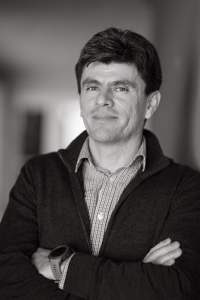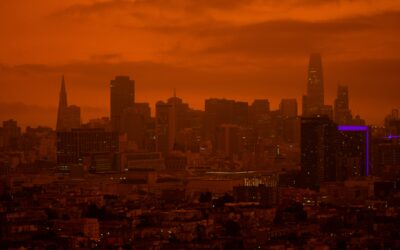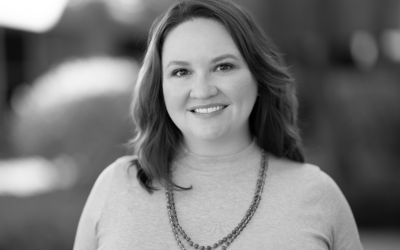Mejia specializes in studying how cities concentrate and increase heat, and recently won a prestigious NSF Mid-Career Advancement Award to support this work.

John Mejia, Ph.D., is an associate research professor of Atmospheric Modeling at DRI. He was recently awarded a Mid-Career Advancement Award from the National Science Foundation (NSF) to support his research on climate change impacts to urban communities, including urban heat islands and air pollution. His weather and climate modeling work supports the research of many other faculty members at DRI, including a collaboration with the Southern Nevada Heat Lab, which examines the feasibility of cooling Las Vegas communities using urban trees. Mejia originally hails from Colombia and works for DRI from his home office in Houston, Texas.
In the following interview, DRI sits down with Mejia to learn more about his research, how he came to DRI, and his plans to bike across Italy.
The interview has been edited for clarity and length.
DRI: Tell us about your background. How did you end up at DRI?
Mejia: It’s a long story, but the short version is that I started my academic background as a civil engineer focusing on hydrology and water resources. For my bachelor’s thesis, I studied precipitation, and that led me to study energy and the climatology of how storms develop in northwestern South America for my master’s. Because I wasn’t a meteorologist, I had a lot of gaps in connecting storms with the environment. At a tropical meteorology workshop in Panama organized by NOAA, I met a scientist who saw my work and believed I had the potential to become a meteorologist. He invited me to pursue a Ph.D. in Oklahoma, which is a focal area for atmospheric sciences. So, my career track became centered around weather, meteorology, and the climate. I first came to DRI as a postdoc with NSF EPSCOR to do atmospheric modeling, and I have managed to grow professionally and thrive—or at least survive—at DRI since then.
DRI: What kind of urban climate solutions are you researching? What is truly effective at lowering temperatures in cities?
Mejia: I focus primarily on modeling how different interventions can bring down temperatures and reduce heat exposure in cities. Ultimately, we use the models to create forecasts to project into the future.
Recently, Las Vegas was calling for removal of grass turf and replacing it with more native landscaping. But it turns out that grass turf helps keep Las Vegas cooler than the surrounding environment. So, removing the turf was going to exacerbate the heat issues in the city.
We developed what we call a “digital twin” for Las Vegas, and in the model, we are simulating the impact of removing the turf while also looking for strategies to cool down the city. We can cool down cities in many ways, but each solution has a different impact. For example, one popular climate solution is urban forestry—really just planting trees—which can help create shade for pedestrians and reduce heating of roads and other land surfaces. That shade helps cool down the city, but there are other tradeoffs to think about: trees reduce wind and therefore the ventilation of the city, and they also need a lot of water to keep alive. Interestingly, some trees also emit volatile organic compounds that interact with air pollutants and exacerbate some pollution issues. So, we need to be careful about what type of tree is planted. We’re using modeling to assess the synergies of these climate solutions to provide evidence about what would be best for the city.
Another popular solution is increasing the reflectivity of surfaces. With more reflective surfaces, the sunlight is reflected back into the sky, which keeps it from heating up surfaces like roads and rooftops. But that has air quality concerns as well—it turns out that many of the chemical transformations that take place in urban skies are related to the interaction between molecules of pollutants and solar radiation. The incoming solar radiation helps catalyze and promote some of those chemical reactions that actually create air pollution. And when you increase the reflectivity of the surfaces, the photons associated with incoming solar radiation have more chances to hit those molecules on the way back up.
DRI: Can the digital twin, or model, examine climate solutions and their tradeoffs for other cities around the world?
Mejia: The digital twins we’re developing for Houston, Las Vegas, Reno, and Phoenix can be used for any city you can think of in the world. We can use it to start querying those difficult questions around how their city interacts with air pollution, wildfire smoke plumes, and these climate solutions, as well as with specific policies.
My work is very collaborative, I like to work with other DRI researchers to find solutions for issues that relate to air pollution, dust transport, global thermal modeling around geoengineering, fires, and air pollution.
DRI: Tell us about your recent award.
Mejia: Recently, I got an award from NSF called a Mid-Career Advancement Award. It is developed to foster the research of mid-career scientists such as associate research professors like myself. Getting NSF funding can be tough, and this award is meaningful. I feel great about having this opportunity to dedicate my research to a narrower area. And now with DRI’s support, as the leadership also believes that this field of study could be something big, I’m realizing that all my effort is worth it. So, I’m investing and focusing on developing that research, and we’re considering hiring more students and postdocs to support the work.
DRI: What research will the award support?
Mejia: I’m advancing my urban climate modeling work to include new elements, like urban canopy and air quality modeling. The grant will enhance this work we are developing around urban canopy modeling to move it to the next level over the next three years.
I’m using Houston as our testbed—for many reasons, even though we care a lot about Las Vegas and Nevada, but Houston is popular for many reasons. It has all kinds of social vulnerability and environmental justice issues in terms of air pollution and heat inequalities. It’s also huge, the fourth largest city in the U.S., and is in a place where heat is a big problem (we just went through the warmest August on record). Houston is also my home. All of that together makes Houston a very important testbed for developing new science around the urban climate.
Additionally, over the last two years, NASA, the Department of Energy, and NSF sponsored an enhanced observation field campaign aiming to understand how the city itself changes the storms. We have found that the city changes the cloudiness and the storminess. This is because the city is capable of concentrating more energy that triggers longer lasting and more intense storms.
DRI: Is that a phenomenon known only in Houston, or is the same true for any city?
Mejia: It’s a signature in many other cities. We’re still trying to understand this, but it seems that the city needs to be large enough to have thermal forces that will promote more moisture convergence and lift. The pollution and particulate matter can also serve as cloud condensation nuclei that can help promote and develop new droplets. And those droplets can now interact with the clouds differently. So, cities can change the environment by changing the thermal structure, and also by changing the hydrology and hydroclimate.
DRI: How did you become interested in studying urban heat?
Mejia: It actually started when I volunteered as a citizen scientist for a NOAA/NIHHIS project aiming to observe the temperature and humidity in cities. And one of those experiments involved people driving a car with a probe outside their window. About 100 of us were asked to drive specific tracks in the city at the same time. And with that information, they made a map showing the hotspots and the complex heterogeneity in temperature and relative humidity of the city.
When I saw that, I thought, ‘Hey, this data is an opportunity.’ And I put together a proposal in collaboration with our sister institution in Houston, the Houston Advanced Research Center. We put together a proposal that was funded and it started focusing my career track around the urban climate.
DRI: What do you like to do when you’re not working?
Mejia: I run—back in my 20s I used to run, bike, swim and scuba dive. But then I started my Ph.D., and training for all these activities and doing a Ph.D. don’t go together. But I kept running and riding my bike more sporadically. At least three days a week I just focus on myself by running. Working from home sort of forces you to do that. But recently I’ve started focusing on a target: to bike the Giro d’Italia behind the official race, as an amateur. It’s a 12-day tour, and every day, we have to bike more than 100 kilometers.
DRI: Is there anything else you think is important to mention?
Mejia: I would say that, in terms of my professional development, I’m always very thankful for the support of my colleagues who see me as part of their solution, as one tool in their tool set. Collaborating with them and interacting with them is crucial as a DRI researcher. Part of where I am right now is thanks to the older folks that believed in me, so I feel very thankful that they keep believing in what atmospheric modelers can provide.
Another note is that heat-related deaths are the number one cause of weather-related mortality in the U.S. But it’s a passive killer, so we don’t pay much attention to it, because it’s not like a hurricane that hits an area and causes deaths all at once. And the infrastructure in the U.S. is really lacking for the extreme heat conditions we’re experiencing. Hopefully, the way we think about heat will accelerate over the next few decades, because it seems like it’s going to be a sticky problem. Thinking specifically about the urban component of heat—where two-thirds of the human population on Earth is— I think, my future investment. It’s a big task, but we need to think about urban climate solutions that account for inequalities, because marginalized communities are the ones that are really being hit by these extreme events. The major challenge I will face over the next decade is how to enhance the social aspects of my research impact.
DRI: Can you talk more about that?
Mejia: I remember a sentence I heard about urban climate solutions—that our mission should not only be to create useful information, but usable information. I see the differences between useful and usable. And the big challenge is that we always claim this information is useful, but making it usable for practitioners is even more important.


